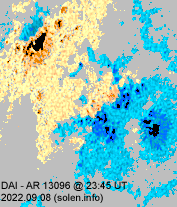13096
N18E82 Data 2022-09-05
Long Jupiter -102 area 30
 New region 13096 [N18E82] 30 rotated into view September 5 as S7841 [N18E82]
New region 13096 [N18E82] 30 rotated into view September 5 as S7841 [N18E82]report(past month only)
13096
N18E69 Data 2022-09-06
Long Jupiter -88 area 30
 New region 13096 [N18E69] 30 rotated into view September 5 and was numbered by SWPC the next day. The region is developing and could produce C flares.
New region 13096 [N18E69] 30 rotated into view September 5 and was numbered by SWPC the next day. The region is developing and could produce C flares.report(past month only)
13096
N18E59 Data 2022-09-07
Long Jupiter -77 area 40
 Region 13096 [N18E59] 40 developed further and produced a few minor C flares. C1 flares: C1.0 @ 15:54, C1.0 @ 17:15, C1.1 @ 18:04, C1.1 @ 23:53 UT
Region 13096 [N18E59] 40 developed further and produced a few minor C flares. C1 flares: C1.0 @ 15:54, C1.0 @ 17:15, C1.1 @ 18:04, C1.1 @ 23:53 UTreport(past month only)
13096
N18E45 Data 2022-09-08
Long Jupiter -62 area 130
 Region 13096 [N18E45] 130 was mostly quiet and stable.
Region 13096 [N18E45] 130 was mostly quiet and stable.report(past month only)
13096
N18E45 Data 2022-09-09
Long Jupiter -61 area 110
 Region 13096 [N18E45] 110 produced a few C flares early in the day. Some penumbral area was lost. C1 flare: C1.2 @ 01:36 UT.
Region 13096 [N18E45] 110 produced a few C flares early in the day. Some penumbral area was lost. C1 flare: C1.2 @ 01:36 UT.report(past month only)
13096
N18E20 Data 2022-09-10
Long Jupiter -35 area 100
 Region 13096 [N18E20] 100 decayed slowly and quietly losing all mature penumbra.
Region 13096 [N18E20] 100 decayed slowly and quietly losing all mature penumbra.report(past month only)
13096
N18E07 Data 2022-09-11
Long Jupiter -21 area 30
 Region 13096 [N18E07] 30 decayed slowly and quietly.
Region 13096 [N18E07] 30 decayed slowly and quietly.report(past month only)
13096
N18W05 Data 2022-09-12
Long Jupiter -8 area 1
 Region 13096 [N18W05] 01 decayed slowly and quietly.
Region 13096 [N18W05] 01 decayed slowly and quietly.report(past month only)
13096
N17W19 Data 2022-09-13
Long Jupiter 7 area 1
 Region 13096 [N17W19] 01 decayed slowly and quietly.
Region 13096 [N17W19] 01 decayed slowly and quietly.report(past month only)
13096
N18W32 Data 2022-09-14
Long Jupiter 20 area 1
 Region 13096 [N18W32] 01 decayed slowly and quietly.
Region 13096 [N18W32] 01 decayed slowly and quietly.report(past month only)
13096
N18W42 Data 2022-09-15
Long Jupiter 31 area 1
 Region 13096 [N18W42] 01 decayed slowly and quietly.
Region 13096 [N18W42] 01 decayed slowly and quietly.report(past month only)
13096
N18W57 Data 2022-09-16
Long Jupiter 47 area 1
 Region 13096 [N18W57] 01 was quiet and stable.
Region 13096 [N18W57] 01 was quiet and stable.report(past month only)